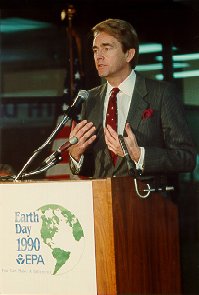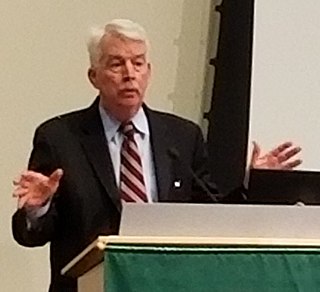
The September 11 attacks on the World Trade Center elicited a large response of local emergency and rescue personnel to assist in the evacuation of the two towers, resulting in a large loss of the same personnel when the towers collapsed. After the attacks, the media termed the World Trade Center site "Ground Zero", while rescue personnel referred to it as "the Pile".

The Environmental Protection Agency (EPA) is an independent agency of the United States government tasked with environmental protection matters. President Richard Nixon proposed the establishment of EPA on July 9, 1970; it began operation on December 2, 1970, after Nixon signed an executive order. The order establishing the EPA was ratified by committee hearings in the House and Senate.

The September 11 attacks transformed the first term of President George W. Bush and led to what he referred to as the war on terror. The accuracy of describing it as a "war" and its political motivations and consequences are the topic of strenuous debate. The U.S. government increased military operations, economic measures, and political pressure on groups that it accused of being terrorists, as well as increasing pressure on the governments and countries which were accused of sheltering them. October 2001 saw the first military action initiated by the US. Under this policy, NATO invaded Afghanistan to remove the Taliban regime and capture al-Qaeda forces.

Christine Temple Whitman is an American politician and author who served as the 50th governor of New Jersey from 1994 to 2001 and as Administrator of the Environmental Protection Agency under President George W. Bush from 2001 to 2003. As of 2024, Whitman is the only woman to have served as governor of New Jersey.

The National Environmental Policy Act (NEPA) is a United States environmental law designed to promote the enhancement of the environment. It created new laws requiring U.S. federal government agencies to evaluate the environmental impacts of their actions and decisions, and it established the President's Council on Environmental Quality (CEQ). The Act was passed by the U.S. Congress in December 1969 and signed into law by President Richard Nixon on January 1, 1970. To date, more than 100 nations around the world have enacted national environmental policies modeled after NEPA.
The mineral asbestos is subject to a wide range of laws and regulations that relate to its production and use, including mining, manufacturing, use and disposal. Injuries attributed to asbestos have resulted in both workers' compensation claims and injury litigation. Health problems attributed to asbestos include asbestosis, mesothelioma, lung cancer, and diffuse pleural thickening.

William Kane Reilly was Administrator of the Environmental Protection Agency under President George H. W. Bush. He has served as president of World Wildlife Fund, as a founder or advisor to several business ventures, and on many boards of directors. In 2010, he was appointed by President Barack Obama co-chair of the National Commission on the BP Deepwater Horizon Oil Spill and Offshore Drilling to investigate the oil spill in the Gulf of Mexico.

Methoxychlor is a synthetic organochloride insecticide, now obsolete. Tradenames for methoxychlor include Chemform, Maralate, Methoxo, Methoxcide, Metox, and Moxie.
Dust to Dust: The Health Effects of 9/11 is a documentary film that was broadcast on the Sundance Channel. It was directed by Heidi Dehncke-Fisher and produced by Bruce Kennedy on September 11, 2006.

Within seconds of the collapse of the World Trade Center in the September 11 attacks, building materials, electronic equipment, and furniture were pulverized and spread over the area of the Financial District of Lower Manhattan. In the five months following the attacks, dust from the pulverized buildings continued to fill the air of the World Trade Center site. Many New York residents have reported symptoms of Ground Zero respiratory illnesses.

As Mayor of New York City on September 11, 2001, Rudy Giuliani played a major role in the immediate response to the terrorist attacks against the World Trade Center towers in the city.
A New Source Review (NSR) is a permitting process created by the US Congress in 1977 as part of a series of amendments to the Clean Air Act. The NSR process requires industry to undergo an Environmental Protection Agency pre-construction review for environmental controls if they propose either building new facilities or any modifications to existing facilities that would create a "significant increase" of a regulated pollutant. The legislation allowed "routine scheduled maintenance" to not be covered in the NSR process. Since the terms "significant increase" and "routine scheduled maintenance" were never precisely defined in legislation, they have become a source of contention in many lawsuits filed by the EPA, public interest groups, and utilities.

Philip John Landrigan, is an American epidemiologist and pediatrician. He has campaigned against substances in the environment that are harmful to children, such as lead and asbestos. He is also concerned with environmental pesticides.

Asbestos is a naturally occurring fibrous silicate mineral. There are six types, all of which are composed of long and thin fibrous crystals, each fibre being composed of many microscopic "fibrils" that can be released into the atmosphere by abrasion and other processes. Inhalation of asbestos fibres can lead to various dangerous lung conditions, including mesothelioma, asbestosis, and lung cancer. As a result of these health effects, asbestos is considered a serious health and safety hazard.

Air quality laws govern the emission of air pollutants into the atmosphere. A specialized subset of air quality laws regulate the quality of air inside buildings. Air quality laws are often designed specifically to protect human health by limiting or eliminating airborne pollutant concentrations. Other initiatives are designed to address broader ecological problems, such as limitations on chemicals that affect the ozone layer, and emissions trading programs to address acid rain or climate change. Regulatory efforts include identifying and categorising air pollutants, setting limits on acceptable emissions levels, and dictating necessary or appropriate mitigation technologies.

The World Trade Center Health Program provides medical benefits to specific groups of individuals who were affected by the September 11 attacks in 2001 against the United States. The WTC Health Program was established by Title I of the James Zadroga 9/11 Health and Compensation Act, P.L. 111-347, which amended the Public Health Service Act. The United States Congress passed the bill in December 2010 and United States President Barack Obama signed it into law on January 2, 2011. The Zadroga Act required the WTC Health Program to begin administering medical benefits on July 1, 2011. On December 18, 2015, the Zadroga Act was reauthorized to provide medical benefits to affected individuals until 2090. The National Institute for Occupational Safety and Health (NIOSH), within the Centers for Disease Control and Prevention, administers the program. The Centers for Disease Control and Prevention is component of the United States Department of Health and Human Services (HHS).

All types of asbestos fibers are known to cause serious health hazards in humans. The most common diseases associated with chronic exposure to asbestos are asbestosis and mesothelioma.

Brenda Mallory is an American lawyer specializing in environmental law who is the current chair of the Council on Environmental Quality in the Biden administration. She previously served as director of regulatory policy at the Southern Environmental Law Center, and helped lead the Climate 21 Project.
Cate Jenkins is a chemist at the Environmental Protection Agency, best known for whistleblowing on possible health effects arising from the September 11 attacks.













